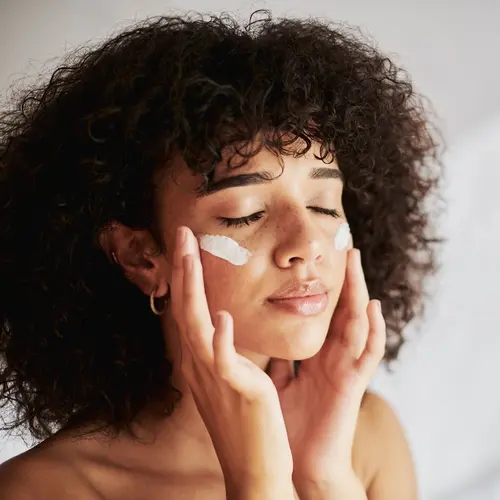Your face changes throughout your life. The process of growing from a baby to an adult is the most dramatic change, but the changes continue throughout adulthood. Weight changes, pregnancy, changes in fitness levels, and injuries can all affect what your face looks like. Your face will also start to get wrinkles in places where your muscles move, such as the areas around your mouth, eyes, and forehead. These deep wrinkles are harder to get rid of than frown lines.
What Causes Frown Lines?
Frown lines, sometimes called worry lines, are the vertical lines that appear between your eyebrows. They are the result of your forehead muscles squeezing inward as you furrow your brows. When you were young, they may have only been noticeable when you made certain facial expressions. Over time, though, the tissue around the muscles might have developed wrinkles that never smooth out.
Does Frowning Cause Wrinkles?
Expression lines are the result of all your facial expressions, not just frowning. Your face makes expressions such as smiling, laughing, or frowning, and the muscles start to get visible traces of your movement pattern. The result is smile lines around your mouth and eyes, horizontal expression lines on your forehead, and frown lines between your eyebrows.
The expression lines on your face can start to look more noticeable as you age. Your skin loses elasticity and firmness, and you may experience fat loss in your face that makes your skin look thinner and your bones more prominent. In addition, the connective tissues in skin and cartilage get weaker, leading to looser skin that reveals expression lines more clearly.
Can I Get Rid of Frown Lines?
Many people find that frown lines between their eyebrows make them look angry or serious, even when they don’t feel that way. You may worry that the appearance of these “11 lines” gives people a false impression of your personality. You may not like having deep lines on your face and want to change them.
You can try using over-the-counter or prescription anti-wrinkle treatments. Those are usually recommended for fine lines and are not as effective on deep wrinkles like frown lines. For the most effective treatment options, you may need to see a dermatologist or plastic surgeon.
What Are the Treatments for Getting Rid of Frown Lines?
Many doctors offer minimally invasive options for reducing the appearance of frown lines. These treatments are effective and have little to no recovery time. They are temporary, and you will need to repeat them to maintain the results. Each treatment will cost several hundred dollars.
Botulinum toxin. One of the most popular treatments for frown lines is botulinum toxin injections. Commonly known as Botox or Dysport, this serum is known as a neuromodulator. When it is injected into a muscle, it causes the muscle to relax and limits its movements.
For frown lines, this treatment means the existing lines look smoother as soon as the injection takes effect. In addition, you can’t move your eyebrows inward anymore, so you don’t make the lines deeper.
The injections only take a few minutes to administer, and there is no recovery time. Some people have mild soreness or bruising at the injection site. It may take up to two weeks to see full results. Neuromodulator injections last 3-6 months.
DaxibotulinumtoixnA-lanm (Daxxify) is a new botulinum toxin product and the first long-lasting peptide-formulated neuromodulator. It can last six to nine months.
Dermal fillers. Another minimally invasive remedy for frown lines is injectable dermal fillers. Dermal fillers, known by brand names like Juvederm and Restylane, are used to reduce wrinkles and add volume to your skin. Your doctor injects the material under your skin to fill in the frown lines and smooth out the appearance of your forehead.
Your doctor can inject filler in the office. You may need a topical numbing cream to ease pain from the injections. The effects are immediate and, depending on the type of filler, last from several months to a year.
Surgery
You can elect to have surgery if you want a permanent solution to frown lines. Surgery has more risks involved, so you should talk to your doctor to make sure it will be safe for you. The results will last for many years, and the procedures can cost thousands of dollars.
Brow lift. A brow lift is a procedure to tighten the skin on the upper part of your face. Sometimes called a forehead lift, this operation can result in a smoother forehead, reduction of wrinkles around the eyes, and a more awake appearance. It can reduce the appearance of frown lines, as well, either by tightening the skin or by removing the muscle that causes the furrowing.
A brow lift usually requires general anesthesia. You may have significant pain, swelling, and bruising after the operation. You will need 10 to 14 days to recover from the procedure.
Facelift. If you want to address all of your facial aging concerns at one time, you can get a full facelift. This procedure tightens the skin of your whole face. You can talk to your doctor about your goals for the operation, and they will address your specific concerns, including frown lines.
A facelift is a significant procedure. It will require general anesthesia, and you may need significant time to recover. Pain, swelling, and bruising are common after the operation. It may take many weeks for the swelling to go down so that you can see the final results.
Talk to your doctor about your options for treating frown lines. They can help you choose the right options for you.


